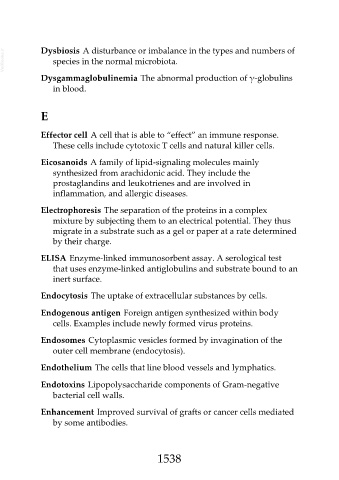Page 1538 - Veterinary Immunology, 10th Edition
P. 1538
VetBooks.ir Dysbiosis A disturbance or imbalance in the types and numbers of
species in the normal microbiota.
Dysgammaglobulinemia The abnormal production of γ-globulins
in blood.
E
Effector cell A cell that is able to “effect” an immune response.
These cells include cytotoxic T cells and natural killer cells.
Eicosanoids A family of lipid-signaling molecules mainly
synthesized from arachidonic acid. They include the
prostaglandins and leukotrienes and are involved in
inflammation, and allergic diseases.
Electrophoresis The separation of the proteins in a complex
mixture by subjecting them to an electrical potential. They thus
migrate in a substrate such as a gel or paper at a rate determined
by their charge.
ELISA Enzyme-linked immunosorbent assay. A serological test
that uses enzyme-linked antiglobulins and substrate bound to an
inert surface.
Endocytosis The uptake of extracellular substances by cells.
Endogenous antigen Foreign antigen synthesized within body
cells. Examples include newly formed virus proteins.
Endosomes Cytoplasmic vesicles formed by invagination of the
outer cell membrane (endocytosis).
Endothelium The cells that line blood vessels and lymphatics.
Endotoxins Lipopolysaccharide components of Gram-negative
bacterial cell walls.
Enhancement Improved survival of grafts or cancer cells mediated
by some antibodies.
1538

